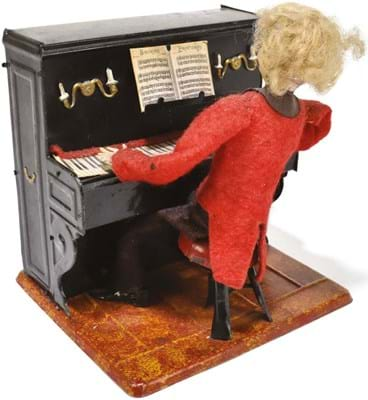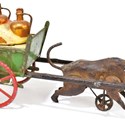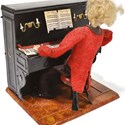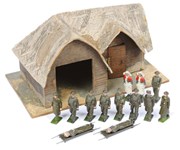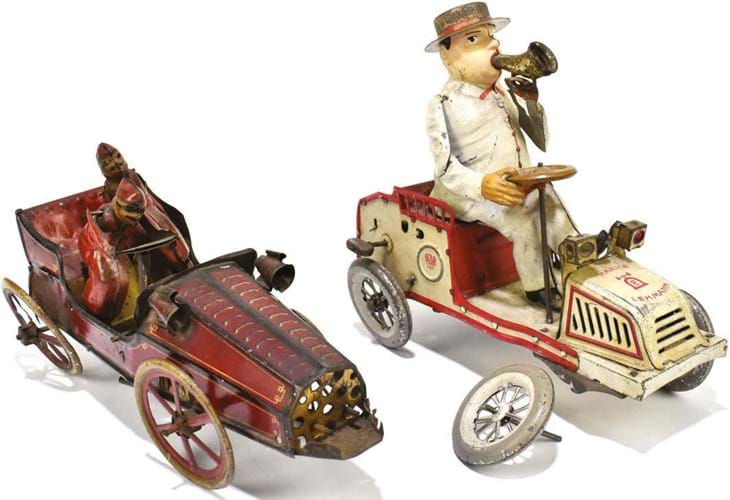
The Lehmann Tut Tut car (on the right) and mystery racing car sold together for £5000 as part of the Tempest collection at Adam Partridge.
They had found fame not least through his books, such as Collecting Tin Toys (1987), which reflected his ethos.
Aaron Dean of the Adam Partridge (20% buyer’s premium) saleroom in Macclesfield, where nearly 230 lots were on offer, said Tempest was interested in the research possibilities as much as owning the individual toy.
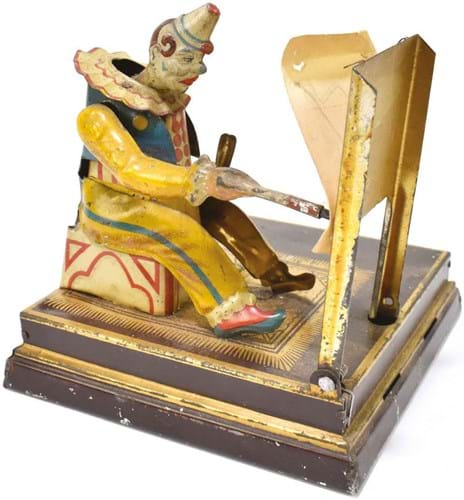
One of the most watched Tempest collection items was this ingenious German tinplate mechanical toy, The Artist, by Philip Vielmetter. It is probably the example illustrated in Tempest’s book Collecting Tin Toys, p77. The mechanism uses cams all about the size of a 50p piece to depict the Queen, Bismarck, Nun, McKinley, Parrot, Punch, Czar, Napoleon, Monkey, Coq, Nansen, Gladstone and Salisbury. The catalogue noted the mechanism ‘does wind although no guarantee of working order’. Aaron Dean said: “What a wonderful bit of engineering – you put essentially a shaped cog on the underside, you crank the mechanism and the arm of the artist will move across with its stylus in its hand and complete the outline.” In the original box (missing lid), it sold for £2050 (estimate £600-1000) to the same Portuguese buyer as the Attalage Flamand also shown.
“He wasn’t in it to make money but he was in it for the enthusiasm and the history,” added Dean, “so he would sell it on to the next collector at private deal or auction but what it made was sort of irrelevant – he had his time with it, had learnt from it, then he would find something else to research. That’s how he operated.”
Tempest had a wide-ranging enthusiasm for toys of all types stretching back a century, encompassing classic early French and German makes (many from the manufacturing hub of Nuremberg) through to Japanese robots.
That interest included games and collectables – also available in this auction – and jigsaws, scientific instruments, musical instruments, phonographs and books, not to mention coins and pocket watches going into another Adam Partridge sale this month.
Name value
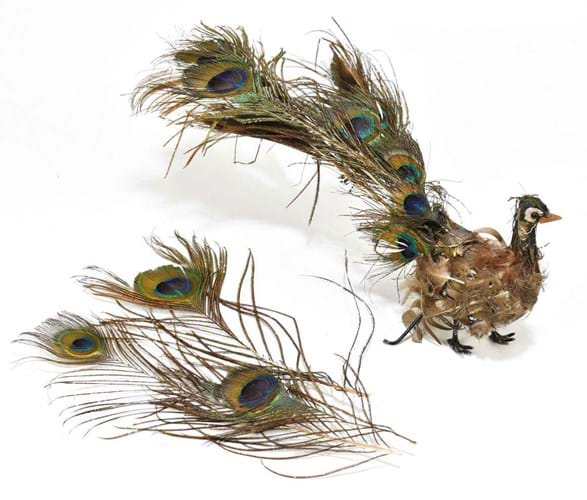
While one bidder did admit to being put off competing for this a rare late 19th century walking peacock or clockwork automaton as the price rose, considering the condition, two others were determined enough to take the result to £1850 – way above the £100-200 estimate. It went on thesaleroom.com to a a private buyer from the south of England. In the original case, the peacock featured real feather plumage and diecast legs, and was about 14in (35cm) long. The catalogue noted: ‘The feathers are in poor condition and several of the tail feather are lacking. No key and has not been wound to see if the mechanism works. The box lacking part of the side and much of the lid.’ The toy was made by French firm Roullett & Decamps. A clockwork automaton model of a pig and dog by the same maker sold for £860.
This toys and collectables section notched up a total just shy of £65,000 with every Tempest lot sold. The Tempest name doubtless added a certain cachet, while most estimates pitched at modest levels brought an enthusiastic bidder response.
Dean – who also had the sizeable task of checking the clockwork mechanisms pre-sale ready for condition reports – said: “It really was a super sale and so much fun to complete for the vendor. Jack’s family were exceptionally pleased with the sale and that every lot sold.”
So pleased in fact they arrived at Dean’s house on the Saturday after the auction to present a big bunch of flowers as a thank you. Tempest, who lived locally, was well known to the saleroom and a personal friend of Partridge himself. When he died his family consigned the collection.
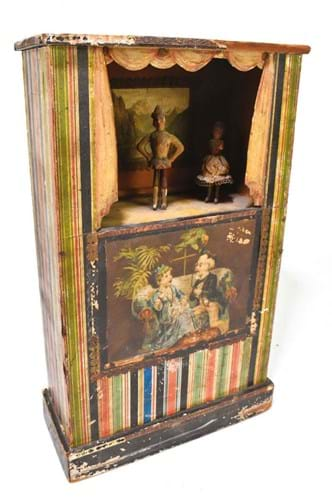
Estimated at £100-150, this 13½in (34cm) high late 19th century Continental musical puppet theatre/puppet show, possibly German or French, has a side crank handle operating a musical box and three puppets. It was catalogued as ‘crank arm does crank and the music plays, all three figures moves’. It was overall ‘a little tired’ but sold for £520 to the same buyer as the two cars pictured top. Aaron Dean said: “He has explained that this little theatre has wooden cogs which makes it German and now that they have opened it to clean and conserve it, it has yielded another surprise in that it has the remains of a silk curtain which should rise and fall as the music starts and stops.”
Originally a Jacquard designer for the textile industry, Tempest’s toys expertise was all self-taught because, as Dean added, “he had just a genuine enthusiasm from childhood for such things. His knowledge developed organically, he became quite an authority on it and, as the family said to me, he would very often buy something, spend a lot of time researching it and write about it as well, obviously sometimes going in those books, and then often would sell things on – a ‘working collection’ I suppose is the best way to describe it.
“The collection brought a lot of people to the room. A lot of enthusiastic collectors, some of whom we knew, some never seen before, which was lovely. We had some great phone bidders and an awful lot of interest online worldwide – US, France, Netherlands, Germany, Denmark, Spain, Japan, Australia and New Zealand all bidding.”
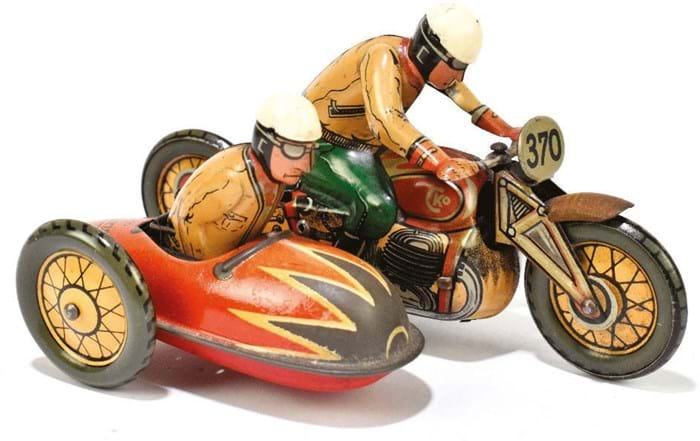
Among a strong selection of clockwork tinplate motorcycle toys was this 5½in (14cm) long CKO Kellermann bike and sidecar, Tourist, No 370. The firm was founded by Georg Kellermann, Nuremberg, 1910. In overall ‘fair condition’, with no key but a mechanism that does wind although it does not run, it took £580 (estimate £50-100) at Adam Partridge online from a regular toy buyer from north-west England.
Research race is on
Despite the copious research, it is somewhat ironic that the top lot remains a mystery – although that does also reinforce the fact that Tempest had such a wide-ranging collection involving minor as well as major manufacturers.
Offered in a single lot was a tinplate clockwork Lehmann Tut Tut car but it was the toy racing car accompanying it that caused a stir. The Tut Tut is relatively common at auction and often makes around £200-300, so it was a shock when the final price for the pair was £5000 against an estimate of £80-120.
The catalogue described the red car, which was marked II.N.13, as ‘incomplete and with rubbing and tarnishing to the decoration throughout and with some surface marks to the back of the vehicle. This vehicle also has solder repairs to the back’. The mechanism of this car was not working.
Dean said: “This was purchased by a private collector from London who knew Jack well. The collector knew many of the pieces in the auction but did not know that Tempest owned this particular red racing car.
“He explained to me that the red car is a ‘very interesting German made race car which I have never seen before’. He also said that other collectors have not seen this example. He is thrilled to have it and it is currently with his conservator having some sympathetic repair work before being added to his collection.”
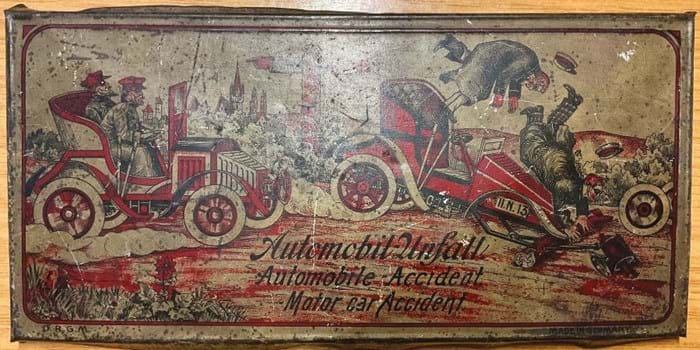
The ‘promotional backdrop’ for the Tut Tut car and mystery racing car sold at Adam Partridge for £5000 is shown here.
Dean had also found in the collection, separate from the car, a tin lid which he realised showed the red car II.N.13 and included it with the lot. That lid had a title Automobil-Unfall Automobile-Accident Motor car Accident, showing the red car pranged from behind – with driver and passenger thrown out – by a car looking a bit like the Tut Tut.
The buyer “believes that the tin lid which accompanies this lot and illustrated the car is not from a box but may be a promotional/advertising backdrop for use in a toy shop with the car standing on a platform in front of it”, added Dean.

Schuco was a German manufacturing company founded in 1912 by Heinrich Müller and the businessman Heinrich Schreyer in Nuremberg. Best known for toy vehicles, these tinplate clockwork figures also proved popular in the Tempest selection. The Charlie Chaplin toy sold for £520 (guide £100-200) and the chef at £780 (£60- 80). The former is thought to be the figure pictured on p84 of Tempest’s Collecting Tin Toys. Both about 6½in (16cm) high and both bought via thesaleroom.com, the Chaplin went to the same Portuguse buyer as the artist and Attalage Flamand also pictured in this feature, while the chef will now serve a private client from the US.



